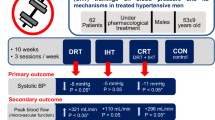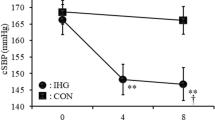Abstract
Isometric handgrip (IHG) training lowers resting blood pressure (BP) in both hypertensives and normotensives, yet the effect of training dose on the magnitude of reduction and the mechanisms associated with the hypotensive response are elusive. We investigated, in normotensive women, the effects of two different doses of IHG training on resting BP, and explored improved resistance vessel endothelial function and heart rate variability (HRV) as potential mechanisms of BP reduction. Resting BP, HRV, and resistance vessel endothelial function (venous strain-gauge plethysmography with reactive hyperemia) were assessed in 32 women before and after 4 and 8 weeks of 3×/week (n = 12) or 5×/week (n = 11) IHG training (four, 2-min unilateral contractions at 30 % maximal voluntary contraction), or 0×/week control (n = 9). IHG training decreased systolic BP in the 3×/week (94 ± 6 to 91 ± 6 to 88 ± 5 mmHg, pre- to mid- to post-training; P < 0.01) and 5×/week (97 ± 11 to 90 ± 9 to 91 ± 9 mmHg, P < 0.01) groups, concomitant with increased forearm reactive hyperemic blood flow (26 ± 7 to 30 ± 8 to 36 ± 9 mL/min/100 mL tissue, P < 0.01; and 26 ± 7 to 29 ± 7 to 38 ± 13 mL/min/100 mL tissue, P < 0.01, respectively), yet both remained unchanged in the control group. No changes were observed in diastolic BP, mean arterial BP, or any indices of HRV in any group (all P > 0.05). In conclusion, IHG training lowers resting systolic BP and improves resistance vessel endothelial function independent of training dose in normotensive women.


Similar content being viewed by others
References
Anderson E, Sinkey C, Lawton W, Mark A (1989) Elevated sympathetic nerve activity in borderline hypertensive humans. Evidence from direct intraneural recordings. Hypertension 14:177–183
Badrov MB, Millar PJ, Horton S, McGowan CL (2013) Cardiovascular stress reactivity tasks successfully predict the hypotensive response of isometric handgrip training in hypertensives. Psychophysiology 50:407–414
Bank AJ, Shammas RA, Mullen K, Chuang PP (1998) Effects of short-term forearm exercise training on resistance vessel endothelial function in normal subjects and patients with heart failure. J Card Fail 4:193–201
Baross AW, Wiles JD, Swaine IL (2012) Effects of the intensity of leg isometric training on the vasculature of trained and untrained limbs and resting blood pressure in middle-aged men. Int J Vasc Med 2012:964697
Chan NN, MacAllistor RJ, Colhoun HM, Vallance P, Hingorani AD (2001) Changes in endothelium-dependent vasodilation and α-adrenergic responses in resistance vessels during the menstrual cycle in healthy women. J Clin Endorcrinol Metab 86:2499–2504
Fagard RH, Cornelissen G (2007) Effect of exercise on blood pressure control in hypertensive patients. Eur J Cardiovasc Prev Rehabil 14:12–17
Fagius J, Karhuvaara S (1989) Sympathetic activity and blood pressure increases with bladder distention in humans. Hypertension 14:511–517
Green DJ, Maiorana A, O’driscoll G, Taylor R (2004) Effect of exercise training on endothelium-derived nitric oxide function in humans. J Physiol 561:1–25
Higashi Y, Sasaki S, Sasaki N, Nakagawa K, Ueda T, Yoshimizu A, Kurisu S, Matsuura H, Kajiyama G, Oshima T (1999) Daily aerobic exercise improves reactive hyperemia in patients with essential hypertension. Hypertension 33:591–597
Higashi Y, Sasaki S, Nakagawa K, Matsuura H, Kajiyama G, Oshima T (2001) A noninvasive measurement of reactive hyperemia that can be used to assess resistance artery endothelial function in humans. Am J Cardiol 87:121–125
Jennings G, Nelson L, Nestel P, Esler M, Korner P, Burton D, Bazelmans J (1986) The effects of changes in physical activity on major cardiovascular risk factors, hemodynamics, sympathetic function, and glucose utilization in man: a controlled study of four levels of activity. Circulation 73:30–40
Kingwell B, Sherrard B, Jennings G, Dart A (1997) Four weeks of cycle training increases basal production of nitric oxide from the forearm. Am J Physiol 272:H1070–H1077
McGowan CL, Levy AS, McCartney N, MacDonald MJ (2007a) Isometric handgrip training does not improve flow-mediated dilation in subjects with normal blood pressure. Clin Sci 12:403–409
McGowan CL, Visocchi A, Faulkner M, Verduyn R, Rakobowchuk M, Levy AS, McCartney N, MacDonald MJ (2007b) Isometric handgrip training improves local flow-mediated dilation in medicated hypertensives. Eur J Appl Physiol 99:227–234
McGowan CL, Swiston JS, Notarius S, Mak S, Morris BL, Picton PE, Granton JT, Floras JS (2009) Discordance between microneurographic and heart-rate spectral indices of sympathetic activity in pulmonary arterial hypertension. Heart 95:754–758
Millar PJ, Bray SR, McGowan CL, MacDonald MJ, McCartney N (2007) Effects of isometric handgrip training among people medicated for hypertension: a multilevel analysis. Blood Press Monit 12:307–314
Millar PJ, Bray SR, MacDonald MJ, McCartney N (2008) The hypotensive effects of isometric handgrip training using an inexpensive spring handgrip training device. J Cardiopulm Rehabil Prev 28:203–207
Millar PJ, Bray SR, MacDonald MJ, McCartney N (2009) Isometric handgrip exercise improves acute neurocardiac regulation. Eur J Appl Physiol 107:509–515
Millar PJ, Levy AS, McGowan CL, McCartney N, MacDonald MJ (2012) Isometric handgrip training lowers blood pressure and increases heart rate complexity in medicated hypertensive patients. Scand J Med Sci Sports. doi:10.1111/j.1600-0838.2011.01435.x
Nelson L, Jennings GL, Esler MD, Korner PI (1986) Effect of changing levels of physical activity on blood-pressure and haemodynamics in essential hypertension. Lancet 2:473–476
Pescatello L, Franklin B, Fagard R, Farquhar W, Kelley G, Ray C (2004) Exercise and hypertension. Med Sci Sports Exerc 36:533–553
Peters PG, Alessio HM, Hagerman AE, Ashton T, Nagy S, Wiley RL (2006) Short-term isometric exercise reduces systolic blood pressure in hypertensive adults: possible role of reactive oxygen species. Int J Cardiol 110:199–205
Pickering TG, Hall JE, Appel LJ, Falkner BE, Graves J, Hill MN, Jones DW, Kurtz T, Sheps SG, Roccella EJ (2005) AHA Scientific Statement: recommendations for blood pressure measurement in humans and experimental animals. Hypertension 45:142–161
Rakobowchuk M, McGowan CL, de Groot PC, Hartman JW, Phillips SM, MacDonald MJ (2005) Endothelial function of young, healthy males following whole body resistance training. J Appl Physiol 98:2185–2190
Ray CA, Carrasco DI (2000) Isometric handgrip training reduces arterial pressure at rest without changes in sympathetic nerve activity. Am J Physiol Heart Circ Physiol 279:H245–H249
Schiffrin E (2004) Remodeling of resistance arteries in essential hypertension and effects of antihypertensive treatment. Am J Hypertens 17:1192–1200
Singh JP, Larson MG, Tsuiji H, Evans JC, O’Donnell CJ, Levy D (1998) Reduced heart rate variability and new onset hypertension. Insights into pathogenesis of hypertension: the Framingham Heart Study. Hypertension 32:293–297
Stiller-Moldovan C, Kenno K, McGowan CL (2012) Effects of isometric handgrip training on blood pressure (resting and 24 h ambulatory) and heart rate variability in medicated hypertensive patients. Blood Press Monit 17:55–61
Task Force of the European Society of Cardiology and the North American Society of Pacing and Electrophysiology (1996) Heart rate variability: standards of measurement, physiological interpretation and clinical use. Circulation 93:1043–1065
Taylor AC, McCartney N, Kamath MV, Wiley RL (2003) Isometric training lowers resting blood pressure and modulates autonomic control. Med Sci Sports Exerc 35:251–256
Tousoulis D, Antoniades C, Stefanadis C (2005) Evaluating endothelial function in humans: a guide to invasive and non-invasive techniques. Heart 91:553–558
Whelton PK, He J, Appel LJ, Cutler JA, Havas S, Kotchen TA, Roccella EJ, Stout R, Vallbona C, Winston MC, Karimbakas J (2002) Primary prevention of hypertension: clinical and public health advisory from The National High Blood Pressure Education Program. JAMA 288:1882–1888
Wiles JD, Coleman DA, Swaine IL (2010) The effects of performing isometric handgrip training at two exercise intensities in healthy young males. Eur J Appl Physiol 108:419–428
Wiley RL, Dunn CL, Cox RH, Hueppchen NA, Scott MS (1992) Isometric exercise training lowers resting blood pressure. Med Sci Sports Exerc 24:749–754
Acknowledgments
The authors would like to thank Don A. Clarke for his technical assistance. The IHG dynamometers used in this study were donated by Zona Health (Boise, Idaho, USA). This work was supported by the University of Windsor (Grant #s 810043; 809264; 808316; CLM), the Canadian Institutes of Health Research (Frederick Banting and Charles Best Canada Graduate Master’s Scholarship; CLB), Heart and Stroke/Richard Lewar Centre of Excellence Postdoctoral Fellowship (PJM), and an Ontario Graduate Scholarship (MBB).
Conflict of interest
Philip J. Millar has received a speaker honorarium from Zona Health (Boise, Idaho, USA).
Ethical standards
The current experiment complies with the current laws of the country in which they were performed (Canada).
Author information
Authors and Affiliations
Corresponding author
Additional information
Communicated by Keith Phillip George.
Rights and permissions
About this article
Cite this article
Badrov, M.B., Bartol, C.L., DiBartolomeo, M.A. et al. Effects of isometric handgrip training dose on resting blood pressure and resistance vessel endothelial function in normotensive women. Eur J Appl Physiol 113, 2091–2100 (2013). https://doi.org/10.1007/s00421-013-2644-5
Received:
Accepted:
Published:
Issue Date:
DOI: https://doi.org/10.1007/s00421-013-2644-5




